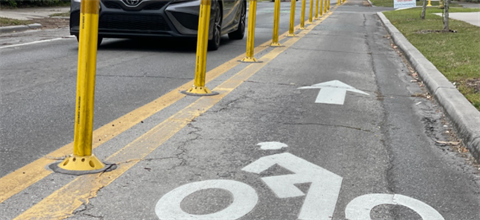New city roads to include bike lanes, safety measures for cyclists and
Published on November 14, 2022

In a move intended to increase safety and comfort for area bicyclists, the Gainesville City Commission recently approved roadway design changes that add bike lanes or adjacent bike paths to all new city streets. In addition, on existing city roadways wide enough to accommodate them, new bike lanes will be added when the roads are resurfaced. The changes apply to new and existing streets with posted speeds of 25 mph or greater that handle at least 3,000 cars each day.
“These improvements support our Vision Zero strategy to reduce the number of traffic fatalities and serious injuries to zero,” said Commissioner Adrian Hayes-Santos. “And a major part of that is how we design our roads to encourage cycling by ensuring there’s a safe place for bicyclists of all ages and abilities.”
Currently, many local roads include conventional bike lanes where a single, solid white stripe separates cyclists from drivers. Under the changes, new bike lanes will fall into one of three categories: buffered, separated or protected.
“Buffered bike lanes are wider, not only creating more distance between the bikes and cars but they also enable one cyclist to comfortably pass another,” explained City Planner Scott Wright.
Separated bike lanes utilize vertical barriers like flexible posts to shield bicyclists from vehicles. Protected bike lanes offer even greater safety and comfort for cyclists by using materials such as curbs, planters or even a parking lane between the bike lane and traffic lane.
“We’ve already started to see these improvements in the midtown area, just north of the University of Florida campus,” said Commissioner Hayes-Santos, referring to new bike lanes added for cyclists along parts of Northwest 14th, 15th, 17th and 18th Streets.
According to the National Association of City Transportation Officials (NACTO), there is a clear correlation between the rise in the number of cyclists on city streets, improved access to safe places to ride and increased safety for riders.
The new improvements support the city’s goals of creating bikeable neighborhoods, and connected trails and paths for biking to link community destinations. The changes are part of recent updates to its Engineering Design & Construction Manual, and are modeled after standards found in the NACTO Urban Bikeway Design Guide.